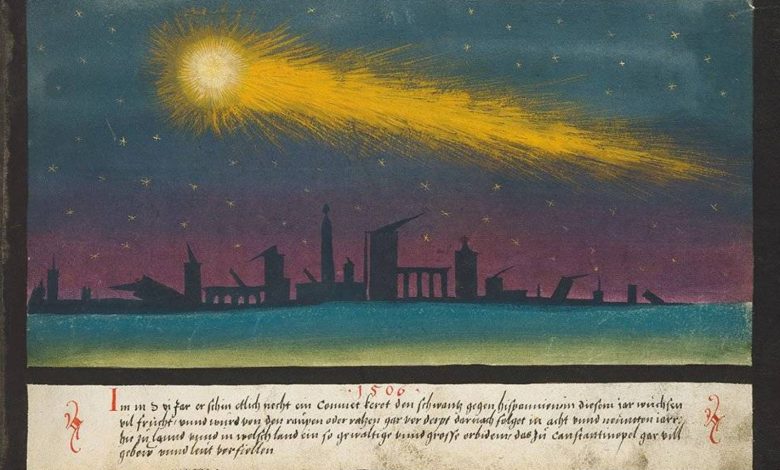
A huge comet so large it’s classified as a “minor planet” has been spotted beyond Uranus coming into the inner Solar System for a once-in 600,000-years visit.
Thought to be a rare long-period comet visiting from as far as half a light-year away, C/2014 UN271 (Bernardinelli-Bernstein)—hence be known as Comet Bernardinelli-Bernstein—is an incredible find and sure to be a major talking point in astronomy until its closest approach in 2031.
Here’s all we currently know about the “comet of the decade:”
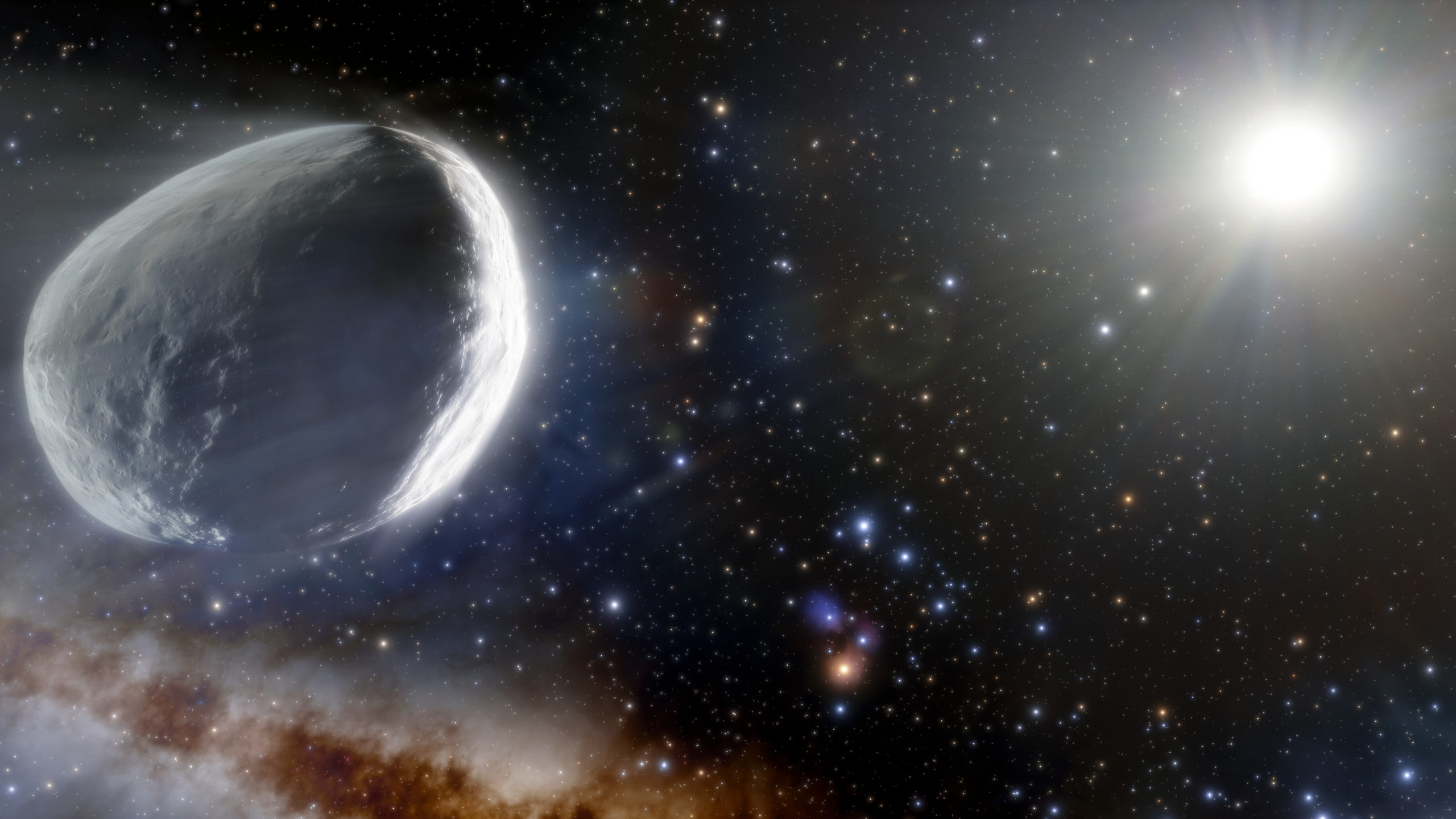
Comet Bernardinelli-Bernstein described
It’s a huge object first discovered about 29 astronomical units (AU) away from the Sun in our Solar System. For context, Earth is one AU from the Sun and Neptune is 30 AU.
Hence Comet Bernardinelli-Bernstein’s initial classification as a trans-Neptunian Object (TNO), which is defined as a minor planet or dwarf planet in the Solar System that orbits the Sun at a greater average distance than Neptune.
According to the latest observations from Las Cumbres Observatory-Sutherland in South Africa, it’s now about 20 AU from the Sun, which is outside the orbit of Saturn.
It’s also just been imaged by the SkyGems Remote Telescope in Namibia and its position mapped by NASA’s Jet Propulsion Laboratory.
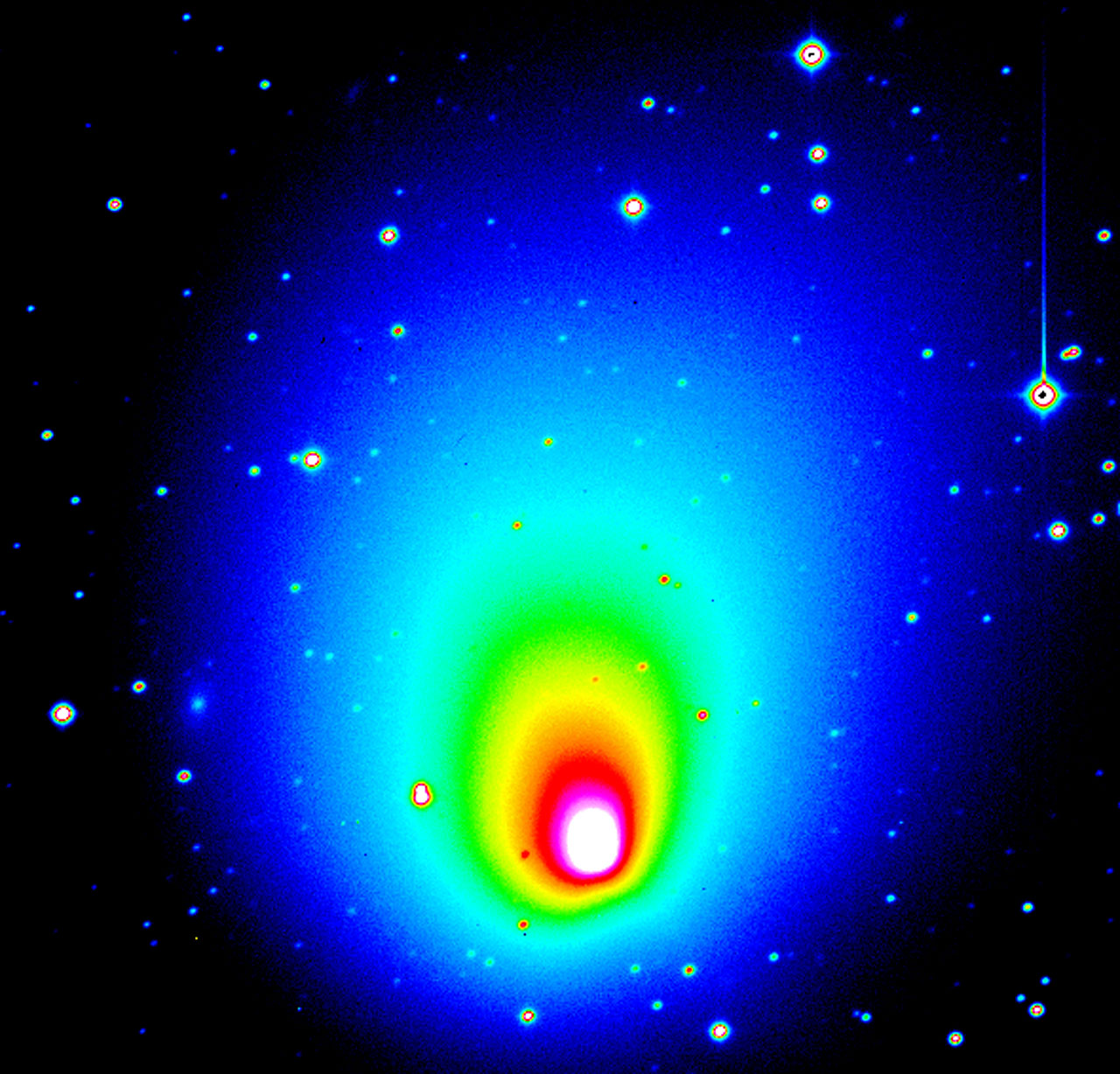
Size of the comet Bernardinelli-Bernstein and Earth impact probability
Astronomers estimate this icy body has a diameter of 62 miles to 124 miles (100 to 200 km), making it about 10 times wider than a typical comet. This estimate is quite rough, however, as the comet remains far away from Earth and its size was calculated based on how much sunlight it reflects. However, Comet Bernardinelli-Bernstein will not strike Earth.
Given its size, that’s just as well. Comet Bernardinelli-Bernstein is one of the biggest comets ever found, the largest being Comet Sarabat (C/1729), the so-called “Great Comet of 1729” that was easily visible to the naked eye.
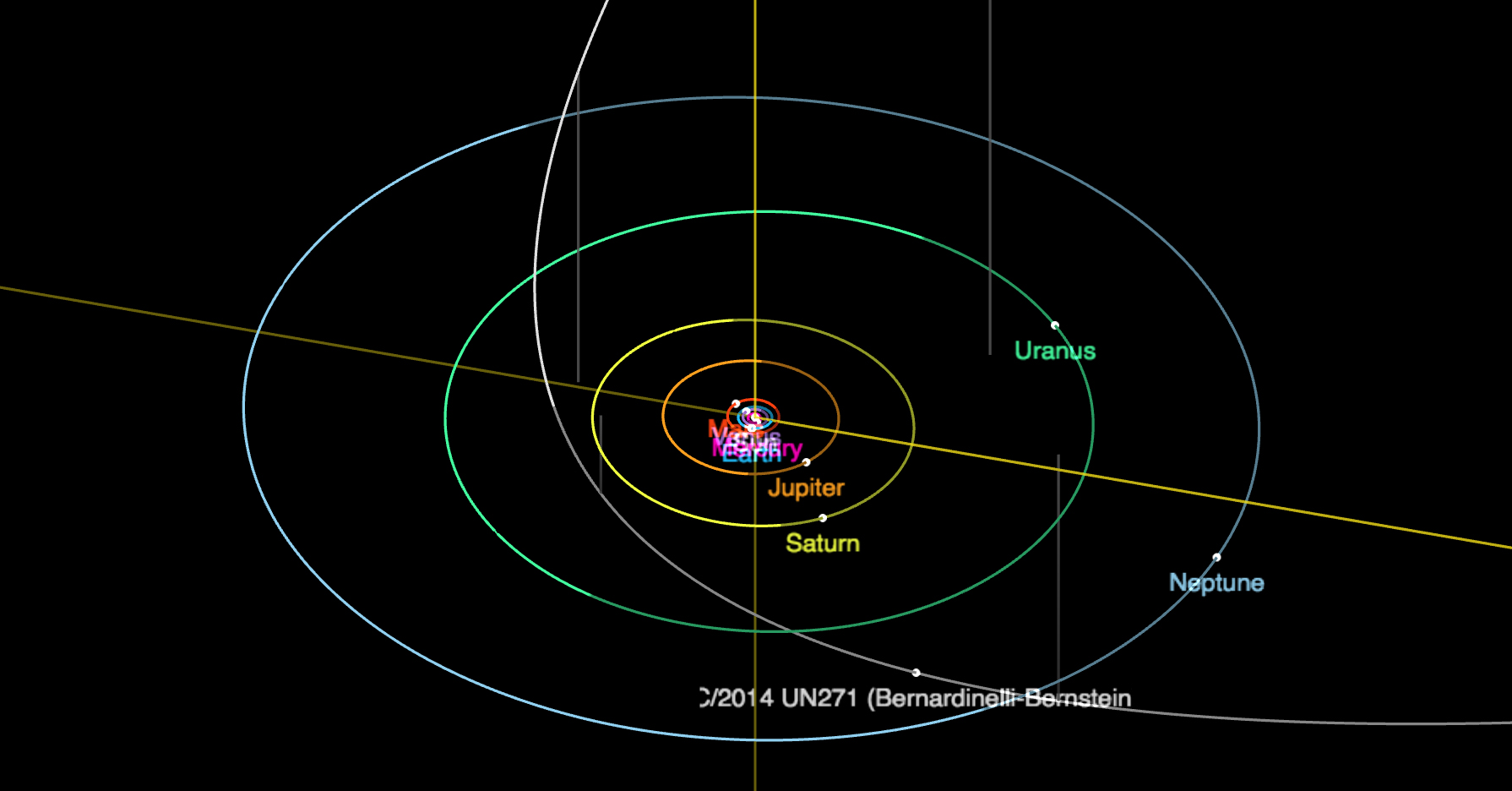
The orbit and current position of the newly discovered mega-Comet Bernardinelli-Bernstein.
Credit: NASA/JPL-Caltech
Founders of the comet Bernardinelli-Bernstein
As first reported by Jonathan O’Callaghan on New Scientist, the object, officially designated a comet on June 23, is called Comet C/2014 UN271 or Bernardinelli-Bernstein after its discoverers, University of Pennsylvania graduate student Pedro Bernardinelli and astronomer Gary Bernstein on June 19, 2021 using archival data from the Dark Energy Survey (DES).
An initial study of data from that six-year mission (2013-2019) published last year found 318 TNOs. This latest search has turned-up another 800 objects—including Comet Bernardinelli-Bernstein.
Comet Bernardinelli-Bernstein source and destination
Comet Bernardinelli-Bernstein is a long-period comet of unknown origin, but it’s thought it could be from the farthest reaches of the Solar System about half a light-year from the Sun. What makes Comet Bernardinelli-Bernstein so special, aside from its size, is the fact it hasn’t visited the inner solar system in three million years, roughly the same era that the famous human ancestor “Lucy” was walking the Earth. The comet originated some 40,000 AU away from the sun in the Oort Cloud, which is a huge, distant region of space thought to hold trillions of comets.
Long-period comets take more than 200 years to complete an orbit around the Sun, but this one is reckoned to on a 600,000-years orbit. Comet Bernardinelli-Bernstein comes from the Oort Cloud, a spherical cloud of icy objects from 50,000 to 100,000 AU from the Sun that surround the Solar System. It’s reckoned that this comet could even be from as far as 60,000 AU.
Halley’s comet is thought to originate from the Oort Cloud.
Like all comets, this one will round the Sun and head off back to where it came from, but the closest it will get to the Sun will be 10.5 AU.
The closest a comet gets to the Sun is called its perihelion. Comet Bernardinelli-Bernstein’s perihelion won’t happen until 2031, so it looks set to be studied for the next decade at least.
Sighting of Comet Bernardinelli-Bernstein
Despite its massive size Comet Bernardinelli-Bernstein sadly won’t ever get close enough to Earth for us to have a look naked-eye. That’s a shame because it’s three times larger than the biggest comet photographed so far—Comet Hale-Bopp in 1997—which wowed the world (more so than “lockdown comet” NEOWISE last summer).
The comet will make its closest approach to our planet in 2031 but will remain at quite a distance even then. In fact, it will only reach magnitude +17 as seen from Earth, which is well out of reach for backyard telescopes.
The good news is that huge telescopes will likely get some great shots—and they could also find a lot more massive comets like Comet Bernardinelli-Bernstein…
“We have the privilege of having discovered perhaps the largest comet ever seen — or at least larger than any well-studied one — and caught it early enough for people to watch it evolve as it approaches and warms up,” Bernstein said in a June 25 statement from the National Science Foundation’s National Optical-Infrared Astronomy Research Laboratory, or NOIRLab.
The comet popped up during a scan of archival images of the Dark Energy Survey, which uses a wide-field 570-megapixel CCD imager mounted on the Víctor M. Blanco 4-meter telescope at Cerro Tololo Inter-American Observatory in Chile. The survey’s main goal is mapping 300 million galaxies across a swath of the night sky, but its deep-sky observations have also yielded several comets and trans-Neptunian objects (TNOs), which are icy worlds orbiting beyond Neptune.

Can we send a spacecraft to visit Comet Bernardinelli-Bernstein?
Since Comet Bernardinelli-Bernstein is going to be in the inner Solar System for about a decade it’s possible a mission will be sent to study it.
After all, it’s from the very farthest edges of the Solar System—60,000 AUs distant—which isn’t a region that’s possible to travel to in a human lifetime.
There's understandably a _lot_ of excitement about the newly-discovered, apparently huge comet, 2014 UN271. Many people are asking whether our mission could reach it. After all, encountering a long-period comet is Comet Interceptor's main aim. Unfortunately,…
— CometInterceptor (@CometIntercept) June 23, 2021
The European Space Agency has a mission called Comet Interceptor that will launch in 2029 in the hope of snagging a long-period comet as it enters the inner Solar System. Seems perfect? It does, but sadly Comet Bernardinelli-Bernstein’s closest point to the Sun—10 AU—is a major problem. That’s about the orbit of Saturn, which is sadly beyond the capabilities of a solar-powered spacecraft like Comet Interceptor (the current farthest solar-powered spacecraft is NASA’s Juno at Jupiter, which is about 5 AU from the Sun).
Will we find more mega-comets?
There are decent chances that someone will launch another, nuclear-powered spacecraft to study Comet Bernardinelli-Bernstein, but meanwhile we do have a huge new observatory that’s ideal for tracking it to its perihelion and beyond.
Currently being built on a remote mountaintop in Chile called Cerro Pachón, the Rubin Observatory’s Legacy Survey of Space and Time (LSST) survey—and its 3,200-megapixel camera—will cover a third of the sky each night and find anything that moves.
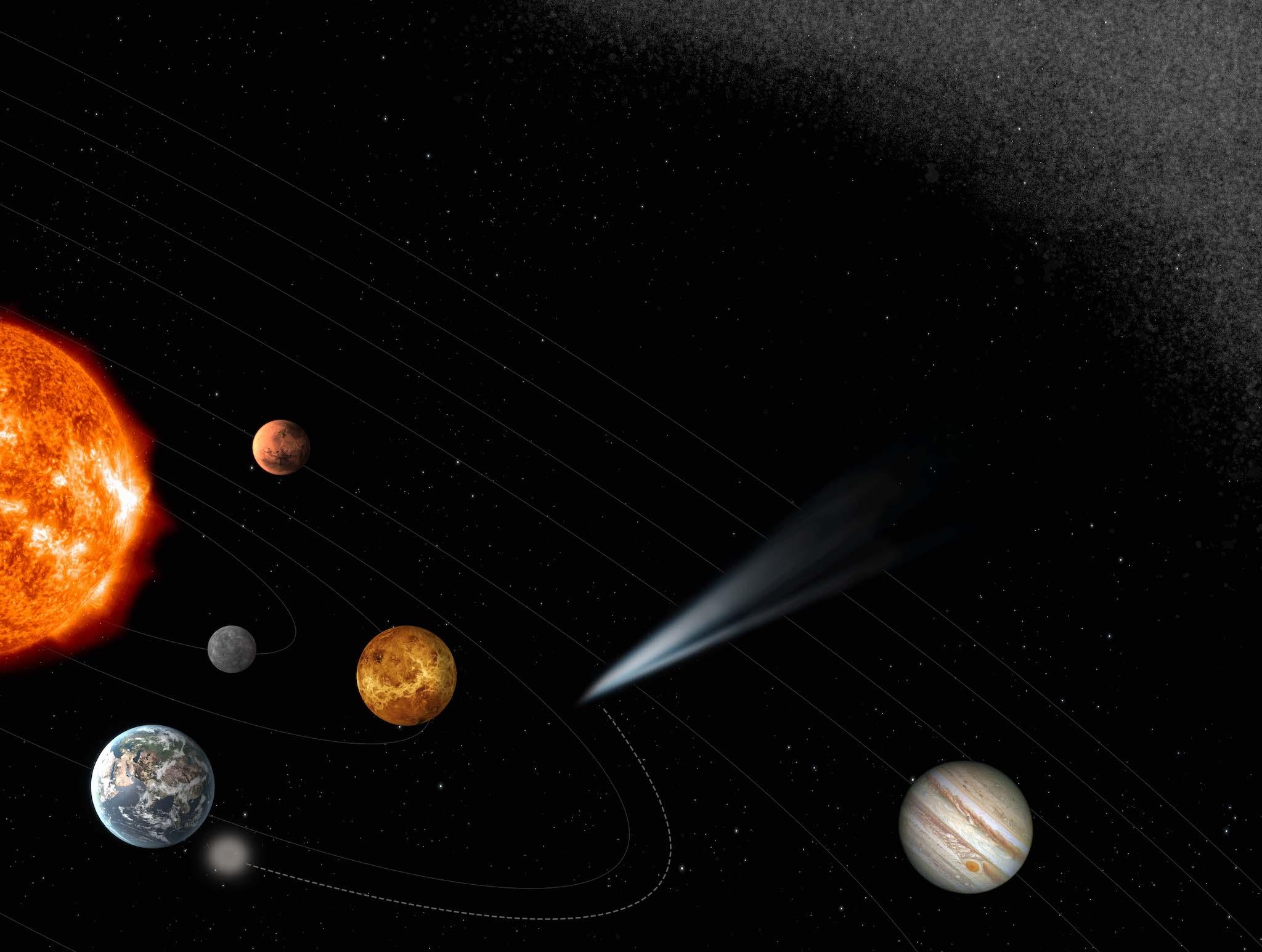
Understanding comet Bernardinelli-Bernstein
Studying the comet will not only give us more insight into how this massive object formed and evolves, but it also could shed light on the early history of giant planet movements in the solar system, NSF officials noted in the same press release.
“Astronomers suspect that there may be many more undiscovered comets of this size waiting in the Oort Cloud far beyond Pluto and the Kuiper Belt,” NSF stated. “These giant comets are thought to have been scattered to the far reaches of the solar system by the migration of Jupiter, Saturn, Uranus and Neptune early in their history.”
While planned cometary observation campaigns are in their early stages, a typical big event usually gets attention from the largest telescopes in space and around the world. By 2031, several newer observatories may be online to look at Comet Bernardinelli-Bernstein.
Upcoming major ground-based observatories include the NSF’s and Department of Energy’s Vera C. Rubin Observatory, whose first light is expected in 2022; the European Southern Observatory’s Extremely Large Telescope, whose first light is expected by 2025; and the Giant Magellan Telescope which should be and running by the late 2020s.
It’s harder to predict if any spacecraft will be able to observe the comet’s approach, because space missions tend to be shorter than the lifespans of ground-based scopes. It’s possible, however, that a future telescope or mission could be funded by 2031 for comet observations that is not yet approved or even planned. The major space agencies may also task existing spacecraft across the solar system to look at Comet Bernardinelli-Bernstein, as happened near Mars in 2014 when Comet Siding-Spring zoomed past the Red Planet.
NASA’s James Webb Space Telescope is scheduled to launch in late 2021 for a prime mission of at least 5 1/2 years, although Webb could run for a decade or more if it remains healthy and funding is maintained, NASA says. The Hubble Space Telescope (currently facing a problematic computer glitch) is famous for comet observations and may be available in 2031, although predictions say it could be healthy through the mid-2020s and will be deorbited no later than the 2030s.
So as well as following Comet Bernardinelli-Bernstein’s progress it could find more—possibly many more—examples of mega-comets.
Wishing you clear skies and wide eyes.
